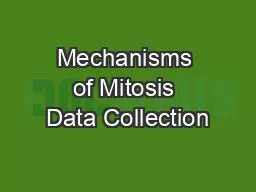

Data Collection Today Group A will collect data from Four untreated control onions Next week Group B will collect data from Four untreated control onions These will comprise ID: 920010
Download Presentation The PPT/PDF document "Mechanisms of Mitosis Data Collection" is the property of its rightful owner. Permission is granted to download and print the materials on this web site for personal, non-commercial use only, and to display it on your personal computer provided you do not modify the materials and that you retain all copyright notices contained in the materials. By downloading content from our website, you accept the terms of this agreement.
Slide1
Mechanisms of Mitosis
Data Collection
Slide2Data Collection
Today
Group A
will collect data from
Four untreated
control
onions
Next week,
Group B
will collect data from
Four untreated
control
onions
These will comprise
eight
control samples
.
Slide3Treatment vs. Control
Between now and next week
, your team may choose to meet
Via Zoom
and/or
In person
, with proper safety protocols
to design a simple experiment
Slide4Treatment vs. Control
Your experimental protocol is due at the beginning of Session 3B.
Based on your project design, you will be provided with micrographs from
8
treatment root
tips.
Slide5Data Collection
By now you should be able to recognize root tip cells in the different stages of mitosis.
Root tips vary in size and quality
Count cells in areas where they are clear and not layered
.
Slide6Data Collection
You should count cells in
FOUR different fields of
view
for each root tip.
For each field of view, record
Total number of cells
Number of cells in each stage of mitosis
Slide7Data Collection
AVOID PSEUDOREPLICATION.
Do not take more than one root from the same onion.
Do not count multiple fields of view from the same root tip as separate samples.
All cells counted from an
indivdual
onion count as
one sample/replicate
.
Slide8Data Collection
Your lab instructor will provide you with an
entire root
from a particular
onion
labeled with an
identification code
(e.g., C1,
C2,
etc.)
With a lab marker,
write the onion’s ID code on the microscope slide
you use for its root tip.
This will help you
keep track of your replicates
detect any problems with a particular onion
Slide9Data Collection
When
you are completely finished with
a slide preparation,
place
it in
the
Broken
Glass Disposal Container
at the front of the lab room.
Teams
leaving slides
at
their station
or on microscope stage will
be docked 5 points.
Slide10Data Analysis: Mitotic Index
The
Mitotic Index
(M)
represents
the proportion/frequency of mitotic cells in your
cell
population.
M
= n
m
/N
n
m
= the number of mitotic cells in the sample (i.e., those not in interphase)
N
= the total number of cells counted in the sample.
Slide11Data Analysis: Mitotic Index
Why might it be useful to compare
mitotic indices
between treatment and control groups?
Slide12Data Analysis: Mitotic Phase Index
A
Mitotic Phase Index (M
P
)
can be calculated for each mitotic phase you encounter.
For example:
M
P
=
n
p
/n
m
n
p
= the number of mitotic cells in prophase in the sample
n
m
= the total number of mitotic cells in the sample
Slide13Data Analysis: Mitotic Index
Why might it be useful to compare
mitotic phase indices
between treatment and control groups?
Do you need to compare
all phases
between treatment and control?
Which phases
would be most useful to compare, given your hypothesis?
Slide14Data Analysis: Mitotic Index
Before you leave lab today,
calculate mitotic indices for each of your
control
samples
.
Enter
them in a table.
Table templates are linked in the syllabus.
Slide15Example of Tabulated Indices
Sample #
(from one onion)
Treatment
(mitotic
index )
Control
(mitotic index
)
1
0.20
0.55
2
0.25
0.60
3
0.45
0.65
4
0.35
0.80
5
0.15
0.35
6
0.10
0.75
7
0.55
0.70
8
0.40
0.85
9
0.30
0.90
10
0.45
0.50
Slide16Data Analysis: Mitotic Phase Index
Decide which
Mitotic Phase Indices (M
P
)
to
use fo
r control and treatment comparison
…
Prophase
Metaphase
Anaphase
Telophase
Interphase
Tabulate your indices in the table templates provided (linked in the syllabus).
Slide17Example: Metaphase Mitotic Phase Index
Sample #
(from one onion)
Treatment
(M
P
for cells in
prophase
)
Control
(M
P
for cells in
prophase
)
1
0.20
0.55
2
0.25
0.60
3
0.45
0.65
4
0.35
0.80
5
0.15
0.35
6
0.10
0.75
7
0.55
0.70
8
0.40
0.85
9
0.30
0.90
10
0.45
0.50
Slide18Your Indices are Your Data
Mitotic Indices
and
Mitotic Phase Indices
of
t
reatment
samples
c
ontrol
samples
…
are the data you will statistically analyze with a
Mann-Whitney U test
once all your data are collected
.
Slide19Your Indices are Your Data
Make
sure
all team members (Group A and Group B) have access
to a copy of
the team’s
index calculations before leaving lab.
Slide20Your Indices are Your Data
Your Homework between Session 3B and Session 4 will be statistical analysis of your data to see if there is a difference between your
treatment
and
control
groups.
Slide21Questions?